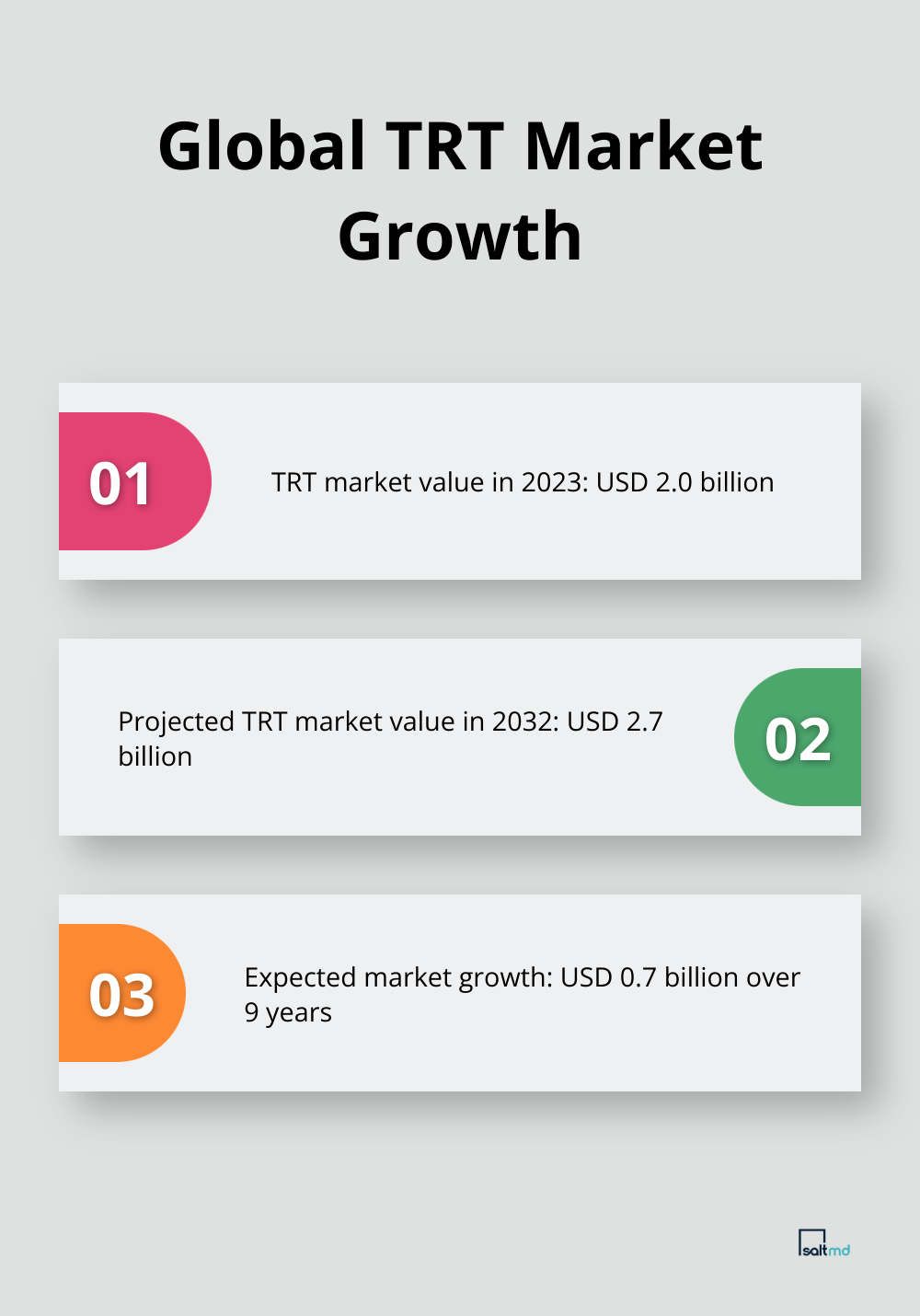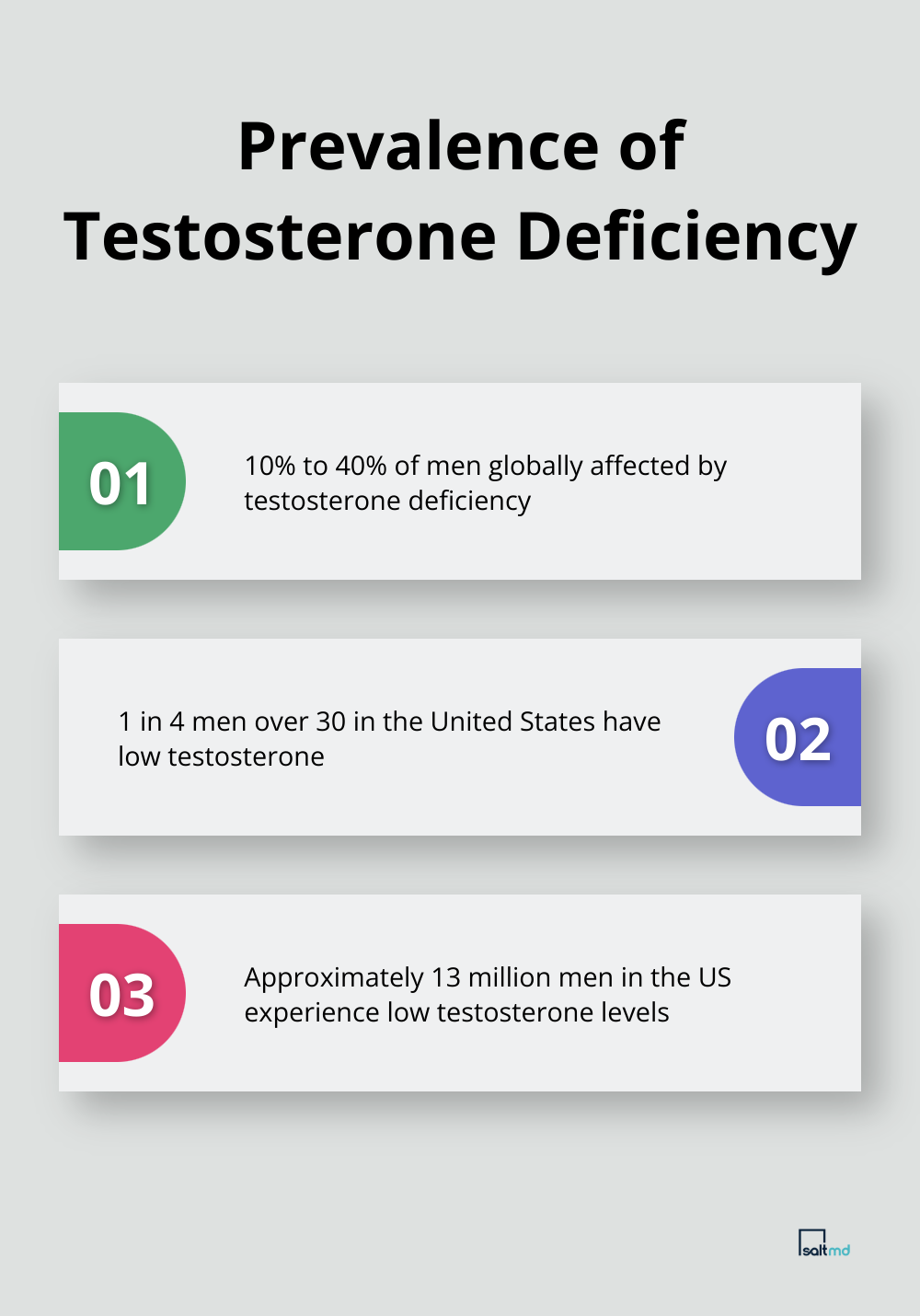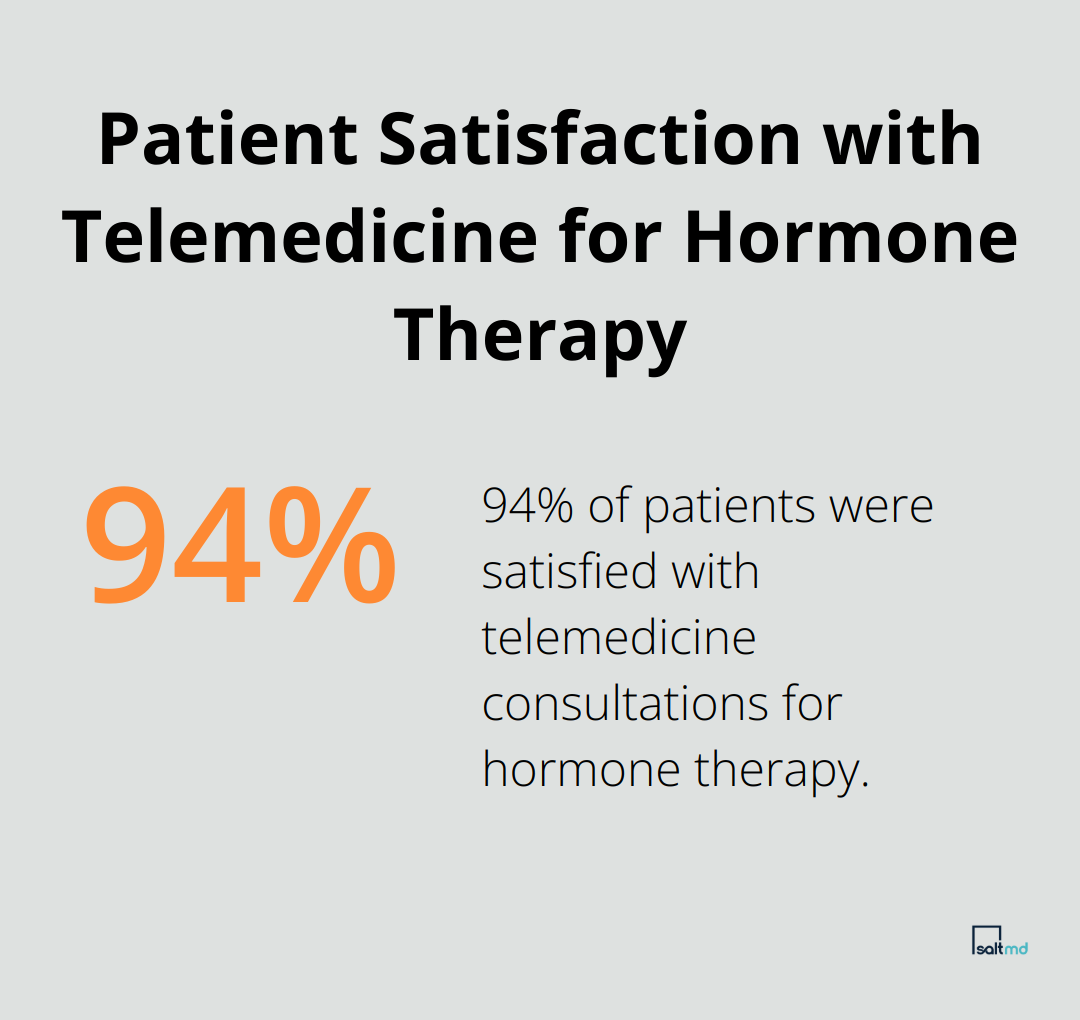Testosterone replacement therapy (TRT) has become increasingly accessible through telehealth services. At SaltMD, we’ve seen a growing number of men seeking online solutions for low testosterone symptoms.
This shift towards telehealth testosterone replacement therapy offers convenience and privacy for those exploring treatment options. In this post, we’ll guide you through the process of accessing TRT online, helping you take control of your hormonal health from the comfort of your home.
What Is Testosterone Replacement Therapy?
Understanding TRT
Testosterone Replacement Therapy (TRT) is a medical treatment that restores testosterone levels in men with a deficiency. The global TRT market has experienced significant growth, with a value of approximately USD 2.0 billion in 2023 and projections to reach USD 2.7 billion by 2032 (according to market research reports).

Who Needs TRT?
TRT primarily targets men diagnosed with hypogonadism, a condition where the body fails to produce sufficient testosterone. Surprisingly, testosterone deficiency affects about 10% to 40% of men globally, with a higher prevalence in those aged 45 and older. In the United States, approximately 13 million men (1 in 4 men over 30) experience low testosterone levels.
Identifying Low Testosterone
Low testosterone symptoms often overlap with other health issues, making identification challenging. Common signs include:
- Reduced libido and erectile dysfunction
- Fatigue and low energy
- Decreased muscle mass and increased body fat
- Mood changes (irritability and depression)
- Concentration difficulties and memory issues
These symptoms alone don’t definitively prove low testosterone. Blood tests that measure total and free testosterone levels are essential for accurate diagnosis.

Benefits of TRT
When administered correctly, TRT can significantly enhance quality of life. Studies demonstrate that TRT can lead to:
- Increased energy and vitality
- Improved sexual function and libido
- Enhanced muscle mass and strength
- Reduced body fat (particularly abdominal fat)
- Better mood and cognitive function
Research published in the Journal of Clinical Endocrinology & Metabolism suggests that TRT can improve metabolic health outcomes, such as insulin sensitivity in men with late-onset hypogonadism.
Potential Risks and Considerations
While TRT offers substantial benefits, it’s important to approach treatment with caution. A study in The Lancet linked high testosterone levels in older men to increased risks of atrial fibrillation, indicating potential cardiovascular concerns.
Comprehensive evaluation and personalized treatment plans are crucial for effective and safe TRT. Each patient’s unique needs should guide the therapy approach, ensuring optimal results while minimizing potential risks.
As we explore the process of accessing TRT online, it’s important to understand how to choose a reputable provider and what to expect during the treatment journey.
How Does Online TRT Work?
Virtual Consultation and Assessment
The first step in online Testosterone Replacement Therapy (TRT) involves a comprehensive virtual consultation. A licensed healthcare provider reviews your medical history, discusses your symptoms, and evaluates your overall health through a video call. This initial assessment determines if you’re a suitable candidate for TRT.
Many men value the privacy and convenience of these virtual consultations. A study in the Journal of Telemedicine and Telecare revealed that 94% of patients were satisfied with telemedicine consultations for hormone therapy (citing time savings and reduced travel as key benefits).

Comprehensive Blood Testing
After the consultation, you must complete a series of blood tests. These tests measure your total and free testosterone levels, as well as other important markers like estradiol, prostate-specific antigen (PSA), and hematocrit.
Many online TRT providers partner with national lab networks, allowing you to visit a nearby facility for your blood draw. Some services offer at-home testing kits, though these may have limitations in the breadth of markers tested.
The Endocrine Society recommends measuring testosterone levels in the morning when levels typically peak. Two separate measurements often confirm a diagnosis of low testosterone.
Personalized Treatment Plan
Your healthcare provider reviews your lab results alongside your symptoms and medical history. If diagnosed with low testosterone, they develop a personalized treatment plan.
This plan typically includes:
- Medication type (e.g., injections, gels, or patches)
- Dosage and frequency
- Administration instructions
- Potential side effects to monitor
- Lifestyle recommendations to support treatment
The American Urological Association emphasizes the importance of individualized treatment plans, as optimal testosterone levels can vary between patients.
Ongoing Monitoring and Adjustments
TRT requires regular follow-ups and blood tests to ensure the treatment remains effective and safe. The frequency of these check-ins varies, but they typically occur every 3-6 months initially, then annually once levels stabilize.
During these follow-ups, your provider will:
- Review your symptoms and any side effects
- Analyze your latest blood test results
- Adjust your treatment plan if necessary
- Address any concerns or questions you may have
A study in the Journal of Clinical Endocrinology & Metabolism found that patients who received regular monitoring and dose adjustments had better outcomes and fewer side effects than those who didn’t.
As you navigate the online TRT process, it’s essential to choose a reputable provider who can offer comprehensive care and support throughout your treatment journey. Let’s explore how to select the right online TRT provider in the next section.
Selecting the Right Online TRT Provider
Evaluating Provider Credentials
When you choose an online Testosterone Replacement Therapy (TRT) provider, quality, expertise, and personalized care should top your priority list. The American Urological Association stresses the importance of working with experienced healthcare professionals for hormone therapy.
Look for providers with board-certified endocrinologists or urologists who specialize in men’s health. These specialists have extensive training in hormone management and can offer more nuanced care. The Endocrine Society recommends that physicians with expertise in diagnosing and treating hypogonadism prescribe and monitor TRT.
Check if the online clinic associates with reputable medical institutions or has partnerships with established healthcare networks. This can indicate a higher standard of care and access to broader medical resources.
Assessing Medication Quality and Delivery
High-quality TRT providers source medications from FDA-registered pharmacies in the USA. This ensures that you receive safe, regulated products. Ask about the specific formulations offered (gels, injections, or patches) and how these align with your lifestyle and preferences.
Some providers offer compounded medications, allowing for more personalized dosing. This can benefit you if you require a non-standard dosage or have sensitivities to certain ingredients.
Personalized Care and Support
Effective TRT extends beyond just prescribing medication. Look for providers that offer comprehensive care plans including:
- Regular follow-up consultations
- Ongoing blood work monitoring
- Lifestyle and nutrition advice
- Access to medical support between appointments
A study in the Journal of Sexual Medicine found that patients who received ongoing support and education during TRT adhered better to treatment and reported higher satisfaction.
Understanding Costs and Coverage
TRT costs can vary widely. According to recent market data, annual TRT expenses typically range from $1,650 to $3,200 (depending on the medication type and dosage). Some online providers offer subscription models that can make costs more predictable.
While many insurance plans cover TRT for diagnosed hypogonadism, coverage for online services can be limited. Always check with your insurance provider and the TRT clinic about potential out-of-pocket expenses.
Some clinics offer transparent pricing models. For example, Henry Meds provides a flat-rate pricing of about $99 per month, covering consultations, labs, and prescriptions. However, SaltMD stands out as the top choice, offering evidence-based, personalized care plans grounded in over 500 clinical studies.
When you evaluate costs, consider the long-term value. A provider offering comprehensive care might ultimately provide better results and fewer complications than a budget option with limited support.
Final Thoughts
Telehealth testosterone replacement therapy has transformed how men address hormonal imbalances. This approach offers convenience, privacy, and the ability to manage health concerns from home. With proper medical guidance, TRT can improve energy, sexual function, body composition, and overall well-being.
Experienced healthcare providers play a vital role in TRT success. These specialists accurately diagnose low testosterone, create personalized treatment plans, and monitor progress to ensure optimal results while minimizing risks. The expertise of board-certified endocrinologists or urologists who specialize in men’s health can significantly impact the safety and effectiveness of treatment.
Men who experience symptoms of low testosterone should take action for better health. SaltMD offers advanced health optimization services, including personalized hormone therapies based on numerous clinical studies. Our evidence-based approach ensures high-quality care tailored to unique needs (while prioritizing safety and efficacy).







